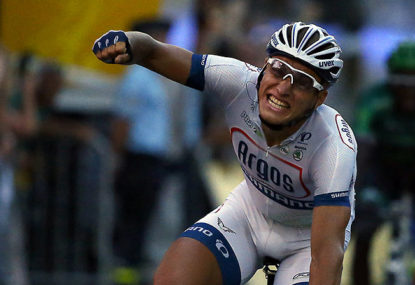'I've just won a stage of the Tour de France, mate!': Hindley grabs yellow jersey as Aussie blows Tour apart
Australia's Jai Hindley has said he is "lost for words" after a shock stage victory at the Tour de France earned him the leader's…

Yorkshire did an astonishingly good job of hosting the Tour de France’s Grand Départ.
Huge crowds, gorgeous countryside, and two challenging stages that defied the usual predictable Tour de France pattern of flat first-week sprint-fests. The rain even stayed away!
Yorkshire (and Northern England in general) has a long history of cycling, and it showed in the way the whole community came out to support the race. Along with some of Britain’s pioneering cyclists, Yorkshire has produced some great frame-builders and bicycle manufacturers. One of my own bikes is from Sheffield, and another was made in Leeds.
So yes, chapeau to Yorkshire, and to the Tour organisers for another inspired choice of location for the beginning of the race.
Right, now the pleasantries are out of the way, let’s get on with the cycling before fatigue catches up with me and I start drooling onto my keyboard.
A nod to Marcel Kittel, who hardly got to enjoy his stint in yellow before it was over. Marcel’s legs were never going to haul his considerable bulk over the magnificently-named Côte de Blubberhouses with the skinny guys. That’s definitely his last chance to lead the race for this year, but I think he’s still got a few stage wins in him, and his army of fans seems to grow every time his magnificent hair and winning smile are seen on camera.
Even so, it’s a bit of a surprise to see newly-minted Italian champion Vincenzo Nibali in yellow so early in the race, but two victories in eight days shows that he’s finally rediscovered his form, after a pretty lacklustre start to the year.
Taking the win in Stage 2 with an opportunistic solo attack was a real crowd-pleaser. At least, I was almost off the couch willing him on – and it’s not easy getting me off the couch at 1:30am.
An in-form Nibali is a real threat to the established favourites Froome and Contador, and he has the support of riders of the quality of Jakob Fuglsang (seventh overall in the 2013 Tour), whose two attacks just before Nibali’s softened up the lead group nicely.
Don’t forget that in 2013 Nibali won the Giro d’Italia (one of the most brutally difficult in recent memory) and was second in the Vuelta a Espana (with some of the steepest climbs in the world). This is a guy who knows how to win Grand Tours and he’s not afraid of high mountains.
I still think Froome and Contador are the favourites, and Nibali himself is playing questions about his overall chances with a dead bat, but he’s obviously improved since the Dauphine and the race is clearly more interesting with him as a credible threat.
Can he hold the yellow jersey? No, he shouldn’t try to. He should let it go to someone who he knows won’t be a threat in 18 days’ time, and save his team’s legs until it really matters.
Stage Two promised to be a miniature version of an Ardennes classic, and so it proved. The kings of the classics were almost all present and accounted for until the final selection on Jenkin Road, which I’m calling the Mur de Jenkin: Peter Sagan, Greg Van Avermaet, Michal Kwiatkowski, Michael Albasini, Alejandro Valverde and Rui Costa made it to the finish; Fabian Cancellara, Jan Bakelants and an injured Simon Gerrans fell just short.
In fact, I think you could easily create a first-rate classic-type race using the roads visited in the first two stages. It would be 280 kilometres of rolling hills, narrow twisty roads, crosswinds and enough murderously steep little climbs to sap the lags and winnow the field down to the real elite.
British Cycling should look into it. Perhaps it’s a better idea in Autumn, when the calendar is less crowded with traditional races.
A few pre-race GC favourites lost a small amount of time: Frank Schleck, Leopold Konig, Matthias Frank, Thibaut Pinot and Pierre Rolland included. It isn’t terminal for any of them yet, but it’s not a good sign for gaps to be opening already.
It does look terminal for Joaquim Rodriguez and Thomas Voeckler, who are both more than 10 minutes down. Rodriguez was seen yesterday carrying water bottles for his team, a sure indication that his legs have just not come back in time for this race. Both riders will now save their energy for stages that suit them.
I’m writing this before Stage 3 takes the race from Cambridge into London, a stage that should belong to the sprinters.
Both cities have a significant bike culture.
The race route eschews some of the more authentic London cycling experiences, like riding the ‘hipster highway’ of Clerkenwell Road, doing a lap of 1948 Olympic venue Herne Hill velodrome, and “riding straight to the kebab shop on the way home because you’ve had a few pints”.
The chosen course past the 2012 Olympic Park at Stratford, down onto the Thames, and past some of London’s most recognisable tourist attractions such as the Tower of London, Tower Bridge, the London Eye, Parliament and Buckingham Palace is obviously better, in a global tourism market sense.
The withdrawal of Mark Cavendish with a karma-related injury also means crash-causing duty will probably be left to the traditional London cyclist-botherers: white van men, minicab drivers and enormous potholes. Here’s hoping none of them are allowed past the barriers.
It should be another belter of a stage finish in a city that has its own rich cycling history and vibrant present-day cycling culture.
Overall, the start of this Tour de France has been a five-star success for England, even if the results haven’t really gone Britain’s way.